The History of the Steam Engine
The first explorations of steam power began in Ancient Greece. A Greek scholar, inventor, engineer from Alexandria named Hero or Heron documented a device, the aeolipile, considered to be the first form of steam engine. The mechanism consisted of a closed container, similar to a globe or cylinder, with vent tubes connected to its sides. When the vessel was filled with water and heated, steam was expelled through the side vents causing the spherical shape to turn on an axis.
Leonardo Da Vinci, in the 15th Century, hypothesized that a cannon could be powered using steam. Though it was never manufactured, the idea was to have a cauldron of heated charcoal where water would be dumped on the cauldron producing steam pressure that would force a screw to turn and project a 71 lb. cannonball. Leonardo did not take credit for the device crediting it to Archimedes.
Over the centuries, several other inventors and scientists investigated, and manipulated steam power, fascinated by its strength and power. In the middle of the 15th Century, Edward Somerset, inventor, nobleman, and politician, created a steam powered engine that was put to practical use, one of many attempts to harness the power of steam.
The Discovery of Steam Power
When discussing the steam engine, it is important to realize its significance to the industrial revolution and how it became the lynch pin to the growth of modern manufacturing. Though there had been steam engine experiments prior to the 16th Century, few of them were practical enough for general use. Each of the configurations was applicable to a specific situation but not for widespread implementation.
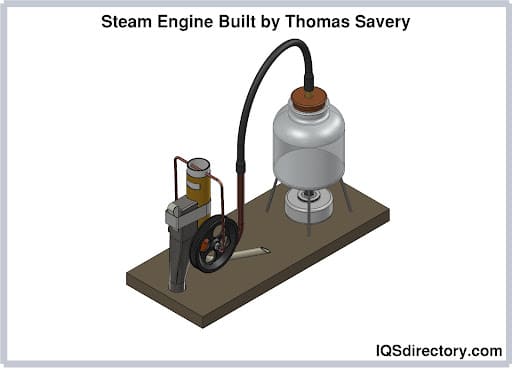
In 1698, an English military engineer and inventor developed the first form of steam engine using the concepts found in a pressure cooker. Thomas Savery had been attempting to resolve the problem of water building up in coal mines. His steam powered invention used a closed receptacle to produce steam under pressure. Cold water was added creating a vacuum that sucked the water out of the mine.
An ironmonger from Devon, United Kingdom, worked with Savery to resolve a similar issue in his mines. Thomas Newcomen owned a mining business that produced coal and tin. As with Savery, he constantly struggled with the problem of flooding in his mines that delayed production and endangered his workers. The hand pumping process used to remove the water was tedious, labor intensive, and further delayed production. To speed up pumping, he used the concepts of Savery to invent a pumping device that used steam power to drive a piston that pulled the water out of the mine.
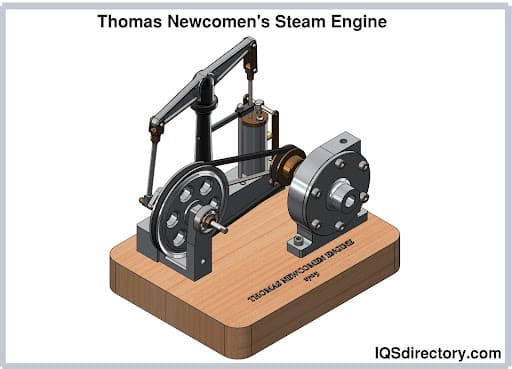
In 1764, James Watt was asked to repair Newcomen’s steam engine. As he worked on the intricacies of the machine, he concluded that the design was flawed and inefficient. Inspired by his findings, Watt decided to take Newcomen’s principles and concepts and improve on them using his understanding of mechanics.
Though Newcomen’s model was sufficient for its purpose, it allowed steam to escape, which decreased the power of the engine. Watt found a way to harness the escaping steam by adding a separate condensing chamber and patented his design as a separate new invention. Watt’s enhancements made the steam engine available to more industries than mining and able to serve multiple functions. Soon after his additions mining, cotton mills, and other industries rushed to incorporate steam power in their operations.
Jonathan Hornblower improved on the work of James Watt and devised a steam engine with two cylinders. He attempted to patent his idea but was thwarted by legal action by Watt. Hornblower’s ideas were lost until being rediscovered by Arthur Woolf who used it as Savery and Newcomen did to pump out mines.
Up to this point, pressurized steam had not been explored. The devices of Savery, Newcomen, and Watt were designed to create a vacuum to drive a piston. Oliver Evans pictured the force of steam in a different way. He designed a method where the force and power of steam pressure pushed a piston creating a more efficient way of converting heat energy to work. This same method was used by Richard Trevithick in the development of his various steam engines.
Richard Trevithick was a visionary who had little practical sense. Though he designed and created several uses for steam power, he was extremely unsuccessful as a businessman and died in poverty. Regardless of his lack of success and his later demise in poverty, he made a significant contribution to the development of steam power with the invention of the boiler. His version of the boiler was named the Cornish boiler, which led to the Cornish Steam Engine, a cheaper, lighter, and smaller engine than Watt’s version.
After leaving the United Kingdom for South America, Trevithick gave the patents for his steam engine to William Sims, who built a number of engines using Trevithick’s designs. Sims’ work was followed by Samuel Chase who made further improvements to the basic design and increased the engines efficiency. Samuel Groase added other features to Chase’s work with the addition of insulation for the boiler, engine, and pipes.
The efficiency of steam engines had a significant impact on manufacturing alleviating the need for labor while improving productivity. The spread of steam power was seen in every aspect of life from factories and businesses to travel and the supply chain. What started as a convenient and efficient means of removing water from mine shafts became a world changing device that paved the way for modern production and commerce.
Steam Power and Travel
The use of the steam engine to power ships is related to the failure of an artist, Robert Fulton. Like men such as B. F. Skinner and William James, Fulton envisioned himself as an artist and worked diligently to create works of art. He was encouraged in his efforts by his friends and relatives to pursue his dream in Europe and learn from the masters. One benefactor was so impressed with Fulton’s works that he financed Fulton’s passage to England. Unfortunately, or fortunately, depending on how you view it, Fulton’s paintings were not critically accepted in London and barely provided enough of a living income.
After admitting his defeat as an artist, Fulton turned his attention to inventing. His first conceptualization was a series of canals that could be cut across the United States to transport people and products efficiently and economically over long distances. His precise details included all of the necessary elements to make the project successful. An interesting side light was his introduction and production of the first underwater warship named the Nautilus, which was rejected as a dishonorable way to fight war.
In 1801, Fulton combined his talents with Robert Livingston to obtain the rights to steamboat navigation in New York state. From their collaboration, Fulton designed and built a 66 foot, eight horsepower engine using a French design with side paddle wheels. Though the design was unsuccessful, Fulton continued his work on a steam powered ship while unsuccessfully trying to sell his submersible weapon concept. In 1807, Fulton finally built a practical steamboat that was ready for passengers and cargo.
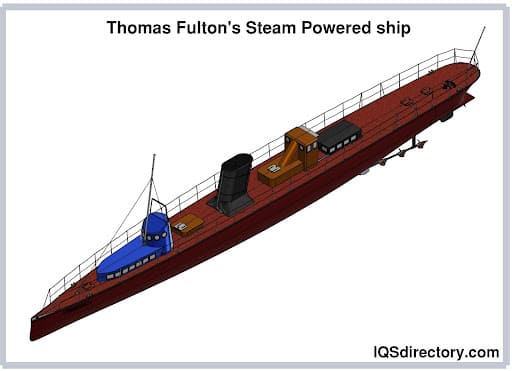
Fulton’s success led to a transportation revolution that opened the way for millions of people to leave their homes and find success in other lands. This was especially seen in the latter part of the 19th Century when thousands of disgruntled and poor people left Europe to build a new life in the United States. It is estimated that close to 10% of the people of Norway emigrated to the United States in hopes of finding a new life in the American west. Countless numbers escaped their homeland finding passage on Fulton’s steamships taking them to the land of opportunity and wealth.
As Fulton perfected his invention, other inventors were exploring unusual and unique opportunities for the use of steam. Though we may credit several visionaries with the development of the horseless carriage, its true beginning was in the early part of the 19th Century with a design by Richard Trevithick. Using the concepts of Oliver Evans’ steam engine, attaching it to the back of a carriage like contraption, Trevithick’s introduced a steam powered vehicle that could reach speeds of four to nine miles per hour. The propulsion system on the carriage was perfect for continuous and smooth motion of the vehicle. When activated, it moved effortlessly and efficiently in a straight line. The problem came when Trevithick tried to make a turn. At that juncture, it went out of control causing terror in nearby citizens.
Early Industrial Uses of Steam Power
The invention of steam power changed the concept of manufacturing and transformed the agrarian societies of Europe and America into industrialized, urban ones. Farm workers and peasants who struggled to make a living in the fields flocked to the slums of cities in the hopes of making a new life. Things that had been handcrafted in small shops were being produced in mass with the use of steam.
For many years, Great Britain was known as the world leader in the production of high quality textiles like wool, linen, and cotton. Prior to the industrial revolution, those fabrics were woven on hand looms in homes and small factories by spinners, weavers, and dyers. In the middle of the 18th Century, the introduction of the flying shuttle, spinning jenny, water frame, and power loom transformed the textile industry making factories capable of producing the same quality cloth faster and economically. More efficient production revolutionized the industry making it able to meet and exceed the growing demand for textile products.
As steam changed the textile industry, it had a similar impact on mining. The use of steam power improved mining techniques and made it possible for miners to dig deeper and extract greater quantities of coal and other ores. Initially, miners had to hand carry loads from mines, which was labor intensive and time consuming. With the introduction of steam power, the raw material could be removed using rail cars and steam powered transports. Also, steam powered bellows and fans produced better ventilation and pumped air deeper into the mine shafts.
Stationary steam engines, introduced in the mid-19th Century, significantly increased the efficiency of steam engines producing more power, using less fuel, and needing less maintenance. The dynamics of this new use of steam was conceived by George Henry Corliss. His machines used the same basic features of piston driven steam engines but incorporated a valve configuration as well as unique gearing.
Corliss’ design used a wrist plate to manipulate a set of valves. Each cylinder of the machine had four valves for exhaust and inlet, similar to modern gas engines. The opening and closing of the valves injected and released steam at a precision controlled rate driving the motion of the pistons. A cut off device assisted in the maintenance of the speed of the engine as well as being able to adjust for load variances and preventing engine damage.
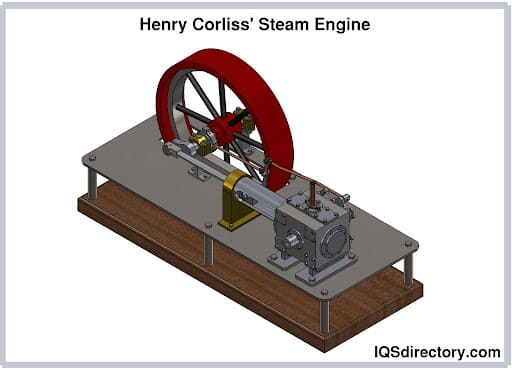
Corliss’ improved process had a dramatic effect on the production of textiles and other industries. The ability of the machines to adjust and change according to loads was significant since industrial production was constantly adjusting during a production cycle. By using Corliss’ engine, rates of production improved, and delays were avoided.
From its implementation in the latter part of the 19th Century, hundreds of Corliss’ machines were in use producing thousands horsepower. Though there were only a little over a thousand of the machines in use, they had a substantial impact on the amount of production power generated. As Corliss perfected and monitored his inspiration, he improved its ability to produce power and run equipment. An example of the importance of Corliss’ contribution to history are the versions of his steam engines in operation today.
Birth of the Railroads
An early source of power, prior to steam, was water. With the advent of steam, waterpower lost its importance since steam driven equipment did not rely on the availability of a water source permitting people to settle in isolated spots. Cities could be built where steam power was prevalent and readily available. This amalgamation of people in several locations proved a benefit to businesses as it increased the number of potential markets and necessitated the expansion of supply lines.
In 1763, Ivan Polzunov had designed a steam engine that used two cylinders on the same shaft. It was a leap forward in the development of steam power and allowed operations in Russia to function without the need of hydropower. In 1765, Polzunov built a 32 hp engine as an air pump, which was installed at the Barnaul steel mills. Unfortunately, Polzunov died at 37 from tuberculosis and was unable to continue his work. His basic concepts were instrumental in the development of the first steam locomotives.
Though Richard Trevithick’s concept of a horseless carriage failed, it did lead to another steam powered invention that furthered advanced travel. Since his machine did so well going in a straight line, he transferred the concept to rails, inventing the first steam powered locomotive designed to haul huge loads. During his life, he made several contributions to steam power and adapted its use for a variety of applications. His most outstanding contribution to steam powered technology was the construction and design of the boiler, which was at the heart of the locomotive engine.
The problem of early rail transportation revolves around the materials to produce the rails since cast iron rails were too brittle to handle the weight of a steam driven engine. During the 18th Century, progressively, iron rails were adapted for the purpose making it possible to transport people and cargo. The first operational rail line appeared in England in 1821 and ran between Stockton and Darlington, a 12 mile stretch. With its beginning, the age of railroads was born.
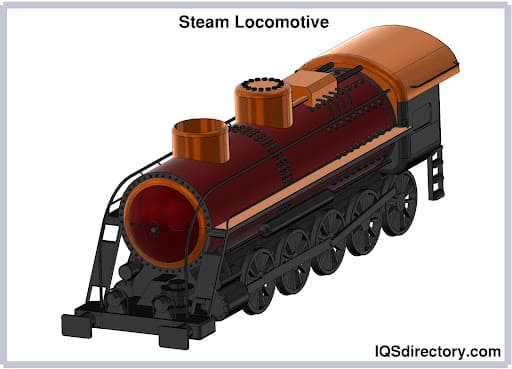
The design of the steam locomotive was somewhat similar to the designs of Newcomen and Savery with a piston driven by steam. Unlike their designs, the locomotive used the pressure of steam, as it was used by Evans and Hornblower, to drive a piston while Newcomen and Savery’s engines used a vacuum to drive the piston. In the case of the locomotive, the boiler sat on top of a fire box where coal was burned to heat the boiler. Steam from the boiler fed into cylinders on the side of the engine that drove pistons to turn the wheels. Historically, the introduction of the steam powered engine was the beginning of the rapid transportation systems of the 21st Century.
Solving a Problem of Steam Engines and Boilers
In the early part of the 20th Century, steam boilers were blowing up at alarming regularity everywhere in the country caused by a problem with the relief valve, a long lever on the end of the boiler designed to relieve pressure in the boiler. Engineers could release pressure by adjusting an iron weight on the end of the lever. When the lever was not in the proper position, the boiler would overheat and explode. In some cases, operators would tighten the relief valve to create more pressure not realizing that it would lead to an explosion. Though explosions were not that common in the early days of steam boilers, the dangers connected with them were ignored until the outbreak of explosions in the early part of the 20th Century.
The blast from a boiler explosion had the potential of destroying a building and sending large sections of iron over long distances. Over the years, there were multiple disasters with each new one being worse than the previous ones. The marvel of steam was being destroyed by its misuse and disastrous effects.
The realization of the dangers of steam pressure were evident in the 15th Century when Denis Papin perfected the first safety valve. He worked with Richard Boyle, founder of Boyle’s Law, in London to improve on his design. Papin’s design was implemented by Watt and other inventors in the 18th Century to ensure safety and provide protection.
Between 1905 and 1911, 1300 people died from boiler explosions. In 1915, the American Society of Mechanical Engineers (ASME) published a set of regulations regarding the construction of boilers and working with materials under pressure. The guidelines of the ASME led to technological devices designed to control and monitor pressure devices used today.
Pressure relief mechanisms are activated by static pressure and designed to open during conditions that are outside the normal operation of the pressure device. When the pressure reaches tolerance above the preset limit, the relief valve activates to bring conditions to acceptable limits. The use of pressure monitors are part of any device that creates pressure from water heaters to spacecraft.
Steam Power in the 21st Century
It may seem that steam is an ancient form of power that has outlived its usefulness. In actuality, the power of steam is everywhere in the 21st Century. Whether the fuel is coal, gas, oil, or even uranium, it is used to heat a boiler containing water to create high pressure steam to move the blades on a turbine. The most advanced power plants are simply a complex boiler.
In the largest cities, steam is pumped into buildings for heating and cooling. Very similar to the disasters of the early 20th Century, steam explosions have occurred in recent history. In 2018, a steam pipe burst in New York forcing the evacuation of several buildings. In 2017, a steam pipe exploded in Baltimore sending debris across several city blocks and creating chaos. The list of such accidents is long and includes several cities in the United States.
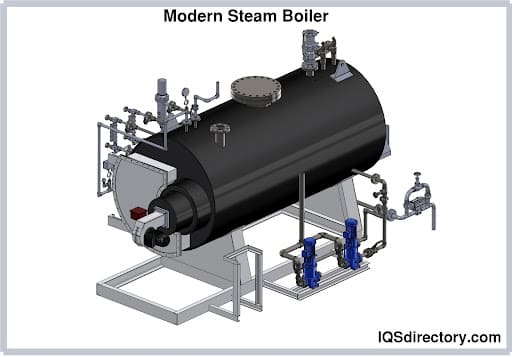
The country of Iceland uses geothermal energy to generate one fourth of its electricity. Wells tap the underground reservoirs of pressurized water that gives off steam to turn turbines at several electricity generating plants.
The uses of this ancient source of power run the gamut of modern applications from food produced in a steamer to the method used to keep food warm in a cafeteria. We may think that technology has moved us from ancient times into the modern world. In reality, ancient inventions are significant parts of powering today’s conveniences.
 Castings & Forgings
Castings & Forgings
 Bulk Material Handling
Bulk Material Handling
 Electrical & Electronic Components
Electrical & Electronic Components
 Flow Instrumentation
Flow Instrumentation
 Hardware
Hardware
 Material Handling Equipment
Material Handling Equipment
 Metal Cutting Services
Metal Cutting Services
 Metal Forming Services
Metal Forming Services
 Metal Suppliers
Metal Suppliers
 Motion Control Products
Motion Control Products
 Plant & Facility Equipment
Plant & Facility Equipment
 Plant & Facility Supplies
Plant & Facility Supplies
 Plastic Molding Processes
Plastic Molding Processes
 Pumps & Valves
Pumps & Valves
 Recycling Equipment
Recycling Equipment
 Rubber Products & Services
Rubber Products & Services